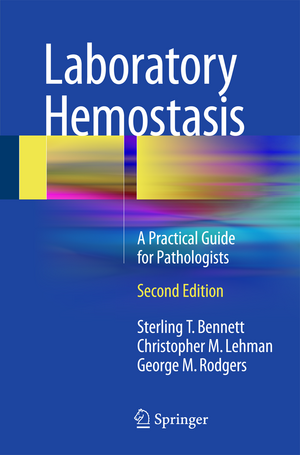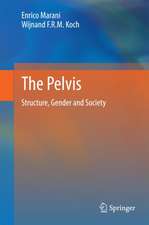Laboratory Hemostasis: A Practical Guide for Pathologists
Autor Sterling T. Bennett, Christopher M. Lehman, George M. Rodgersen Limba Engleză Paperback – 31 oct 2014
Preț: 646.64 lei
Preț vechi: 680.67 lei
-5% Nou
Puncte Express: 970
Preț estimativ în valută:
123.73€ • 129.19$ • 102.41£
123.73€ • 129.19$ • 102.41£
Carte disponibilă
Livrare economică 10-17 martie
Livrare express 28 februarie-06 martie pentru 67.10 lei
Preluare comenzi: 021 569.72.76
Specificații
ISBN-13: 9783319089232
ISBN-10: 3319089234
Pagini: 205
Ilustrații: XII, 205 p. 27 illus.
Dimensiuni: 155 x 235 x 15 mm
Greutate: 0.38 kg
Ediția:2nd ed. 2015
Editura: Springer International Publishing
Colecția Springer
Locul publicării:Cham, Switzerland
ISBN-10: 3319089234
Pagini: 205
Ilustrații: XII, 205 p. 27 illus.
Dimensiuni: 155 x 235 x 15 mm
Greutate: 0.38 kg
Ediția:2nd ed. 2015
Editura: Springer International Publishing
Colecția Springer
Locul publicării:Cham, Switzerland
Public țintă
Professional/practitionerCuprins
Role and Responsibilities of the Laboratory Director.- Collection of Coagulation Specimens.- Instrumentation for the Coagulation Laboratory.- Validation of Coagulation Assays, Instruments and Reagents.- Hemostasis Screening Assays.- Testing for Inherited Bleeding Disorders.- Testing for Acquired Platelet Disorders.- Acquired Coagulation Disorders and TTP.- Testing for Inherited and Acquired Thrombotic Disorders.- Monitoring of Anticoagulant Therapy.- Pharmacogenomics and Pharmacogenetics.- Coagulation Testing and Transfusion Medicine.
Recenzii
From the book reviews:
“The purpose is to provide a single reference with information and guidance related to directing a clinical coagulation laboratory. The book is intended for everyone involved in clinical coagulation testing -- residents and fellows, clinical laboratory scientists, pathologists, or doctoral level scientists involved in directing a clinical coagulation laboratory. It would also be of interest to ‘users’ -- e.g., clinical hematology consultants. … This is a must-have for any clinical coagulation laboratory director.” (Valerie L. Ng, Doody’s Book Reviews, January, 2015)
“The purpose is to provide a single reference with information and guidance related to directing a clinical coagulation laboratory. The book is intended for everyone involved in clinical coagulation testing -- residents and fellows, clinical laboratory scientists, pathologists, or doctoral level scientists involved in directing a clinical coagulation laboratory. It would also be of interest to ‘users’ -- e.g., clinical hematology consultants. … This is a must-have for any clinical coagulation laboratory director.” (Valerie L. Ng, Doody’s Book Reviews, January, 2015)
Textul de pe ultima copertă
Coagulation testing is the basis for the diagnosis of bleeding and thrombotic disorders, as well as the mainstay of anticoagulant monitoring and management. This handbook provides practical information and guidance on topics relevant to directing a coagulation laboratory, filling a void in the literature. The book cites consensus recommendations of authoritative bodies whenever possible, and otherwise refers to reviews, chapters, and research articles from experts. Since the first edition, all chapters have been updated, and an entirely new chapter is included on pharmacogenomics and pharmacogenetics.
Laboratory Hemostasis: A Practical Guide for Pathologists will aid pathologists, clinical laboratory scientists, and other physicians serving as laboratory directors to understand and carry out their responsibilities. It will also assist residents and fellows in learning the basics of coagulation testing and serve as a useful day-to-day reference for coagulation laboratory supervisors, technologists, and technicians. Finally, clinicians may find aspects of the book helpful in understanding the role of the coagulation laboratory in patient evaluation and monitoring.
Laboratory Hemostasis: A Practical Guide for Pathologists will aid pathologists, clinical laboratory scientists, and other physicians serving as laboratory directors to understand and carry out their responsibilities. It will also assist residents and fellows in learning the basics of coagulation testing and serve as a useful day-to-day reference for coagulation laboratory supervisors, technologists, and technicians. Finally, clinicians may find aspects of the book helpful in understanding the role of the coagulation laboratory in patient evaluation and monitoring.
Caracteristici
Provides practical information and guidance on how to run a coagulation laboratory Covers the basics of coagulation testing for residents and fellows Addresses targeted questions relevant to day-to-day practice







